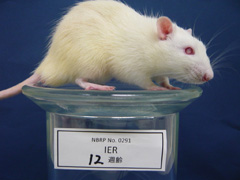| NBRP Rat No: 0291 |
Strain name: IER/Ihr |
Commmon Name: IER, IGER, Ihara's genetically epilepsy rat |
Rat Genome Database |
| Principal Investigator: |
Nobuo Ihara Institute of ICR research 3-17, 4-chome, Matsuigaoka, Kyotanabe-city 610-0353 Kyoto Japan |
| Tel: 0774-62-6448 Fax: 0774-65-1123 |
Email: |
| Preservation Status: |
Embryo Sperm Living Animals |
 |
![]() |
| Coat Color |
albino (c) |
| Inbred Generations |
F79+18 (April 2012) |
| Usage Restrictions |
The recipient of BIOLOGICAL RESOURCE shall obtain a prior written consent on use of it from the DEPOSITORS. The recipient is requested to confer with DEPOSITORS, before publication, about the report on the investigated results obtained by using the RESOURCE. |
| Genetic Status |
|
| Comercial Availability |
|
|
| Research Category |
|
| Gene Affected |
|
| Origin |
IER (former name was IGER: Ihara's Genetically Epilepsy Rat) strain has been developed by selective breeding from spontaneous seizure phenotype from ICR (Ihara Cataract Rat) strain. (Sep 24, 2009) |
| Strain characteristics |
Hyperactivity starts from about 8 weeks of age in males. Facial or mandible myoclonus and wet dog shaking are recognized at 10 to 12 weeks of age. Almost all males show generalized convulsions, mostly from 5 months of age and about 20 % of the females develope generalized convulsions. Generalized tonic clonic seizure typically continues for 15-20 seconds (Amano, 1996). Both 2 and 12 month-old IER rats show abnormal neuronal clusters and disarrangement of pyramidal neurons in the CA1 of the hippocampus (Tsuji, 2001). The mode of inheritance of cataract in IER rats was analyzed by breeding experiments and cataract-related genes, Cati1 and Cati2 were mapped on chromosome 8 and 15 respectively by QTL analysis (Yokoyama, 2001). (Sep 24, 2009) |
| Breeding Conditions |
A foster mother is required. |
| Genotyping |
|
| References |
Serikawa T, Mashimo T, Kuramoto T, Voigt B, Ohno Y, Sasa M.
Advances on Genetic Rat Models of Epilepsy.
Exp Anim. 64(1):1-7. 2015.
Tsuji A, Amano S, Yokoyama M, Fukuoka J, Hayase Y, Matsuda M.
Neuronal microdysgenesis and acquired lesions of the hippocampal formation connected with seizure activities in Ihara epileptic rat.
Brain Res. 2001 May 18;901:1-11.
Kurazono S, Okamoto M, Sakiyama J, Mori S, Nakata Y, Fukuoka J, Amano S, Oohira A, Matsui H.
Expression of brain specific chondroitin sulfate proteoglycans, neurocan and phosphacan, in the developing and adult hippocampus of Ihara's epileptic rats.
Brain Res. 2001 Apr 13;898:36-48.
Yokoyama M, Amano S, Tsuji A, Sasahara M, Serikawa T, Ihara N, Matsuda M, Hazama F, Handa J.
Genetic analysis of cataract in Ihara epileptic rat.
Mamm Genome. 2001 Mar;12:207-11.
Takahashi Y, Tsunashima K, Sadamatsu M, Schwarzer C, Amano S, Ihara N, Sasa M, Kato N, Sperk G.
Altered hippocampal expression of neuropeptide Y, somatostatin, and glutamate decarboxylase in Ihara's epileptic rats and spontaneously epileptic rats.
Neurosci Lett. 2000 Jun 23;287:105-8.
Amano S, Ihara N, Uemura S, Yokoyama M, Ikeda M, Serikawa T, Sasahara M, Kataoka H, Hayase Y, Hazama F.
Development of a novel rat mutant with spontaneous limbic-like seizures.
Am J Pathol. 1996 Jul;149(1):329-36
|
| Additional strain information |
|
|
|